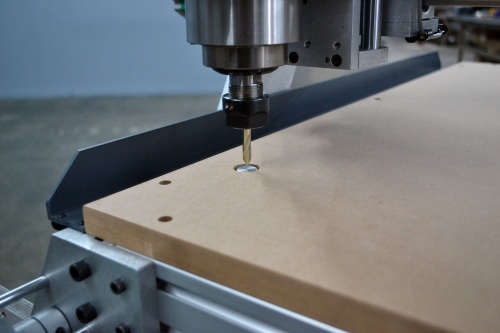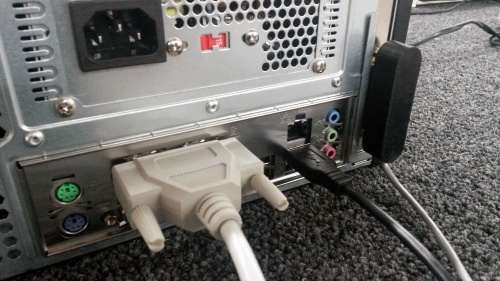Difference between revisions of "Automatic Tool Length Sensor"
From PROBOTIX :: wiki
| Line 78: | Line 78: | ||
=Installing the Sensor= | =Installing the Sensor= | ||
| − | You should receive a tool sensor connected to a parallel port connector. | + | You should receive a tool sensor connected to a parallel port connector. Mount unit to the machine. Mount it anywhere on the machine that the tool can reach. On our machines we place it down in the left hand corner closest to the front of the machine. Machines purchased in 2015 will already have the hole in the spoil board for this mounting location otherwise you will need to drill a 3/4" hole in the spoil board that the plunger will sit in. If you are going to remove your spoil board to do this you can use M5 studs to help get the spoil board back down over the T-nuts. It's easy to make your own studs by cutting the head off a longer M5 screw. (pic placeholder) |
| + | |||
| + | =LinuxCNC= | ||
| + | You will want to download a new configuration for LinuxCNC for your machine with a tool sensor. Any PCs bought after 2015 will already have the config, if yours is older you may need to download the config from here: [[Link title]] | ||
| + | |||
| + | Make note of your config (the name of your desktop icon for LinuxCNC) and download the same config that includes "TS" from here: | ||
=Your PC parallel port= | =Your PC parallel port= | ||
| − | + | Your PC should have a secondary parallel port the DB25 connector for the sensor will attach to. Next we will need to find out the address of the parallel port card. Most of the time these cards will initialize to 0xd050, but not always. That is determined by processing done in the BIOS and there doesn't seem to be any rhyme or reason as to what that address becomes. To check if it's working out of the box, open LinuxCNC | |
| + | |||
| + | |||
| + | To find it, open up a terminal session (similar to a windows dos prompt) go to Applications, Accessories, Terminal. (pic placeholder) | ||
| + | Type the command lspci -v | ||
| + | This will list data about everything attached to the PCI bus. Usually the add on card shows up at the bottom of the list but not always. You will be looking for something like NetMos tech PCI 9815 multi-I/O controller. In that section it will list the I/O ports for that device with the address next to it. (pic placeholder) Make note of the first two addresses in the list. It's usually the first one but sometimes it's the second one. | ||
| + | |||
| + | |||
| − | |||
| − | |||
=CAM Software= | =CAM Software= | ||
Revision as of 15:26, 7 February 2015
When using multiple tools on a CNC operation, the z-axis is always the goofy axis because, for instance, the lengths of the tools are all different and the distance the tool is inserted into the collet can vary widely - both intentionally and unintentionally. With conventional CNC routing, each tool operation has to be done in a separate g-code file, with each tool needing to be touched off in the z-axis on each tool change.
The new ATLaS automatic tool length sensor for the Comet/Asteroid/Meteor machines radically optimizes this tool change process. With the tool length sensor, you will load the first tool, then the machine will capture the tool length with the sensor before you touch that tool off to the top of the part. This will establish the z-axis origin and you will only have to touch off the top of the part this one time. On each tool change, the machine will shut off the spindle and drive out to the front of the machine to allow for easy tool change access. The machine will then drive over until it is above the tool sensor, will bounce off of that sensor, will then continue with the cutting process using the new compensated tool length offset.
The tool sensor can measure tools up to 5/8" diameter. You can still use larger tools if you need, but you will not be able to use the automatic tool length sensor when you do. The sensor sits just below the surface of the spoil board. You can make use of that area of the table if you need, but again you will not be able to use the automatic tool length sensor when you do.
To use the this Automatic tool length sensor, your CAM post-processor will need to be modified such that the tool change function is no longer g-code M6. The tool change function typically looks like this:
M6 T1
The new tool change function will look like this:
o100 CALL [1]
For metric, the tool change will look like this:
o101 CALL [1]
We will post modified post processors here on the wiki as we compile them. Please contact us if you need help modifying a post processor.
Here is the tool change routine. This file is named 100.ngc and must be kept in the nc_files directory.
o100 SUB (#1 must be passed as tool number) #30 = ROUND[#5220] (stores the current coordinate system) M9 G59.3 (use G59.3 as zero location for touch sensor) G53 G90 G0 Z0 G53 X12.5 Y0 T#1 M6 G0 X0 Y0 G91 G38.2 Z-5 F10 G10 L11 P#1 Z0 R0 G53 G90 G0 Z-.1 G43 G91 Z0.1 G90 (reset to the previous coordinate system) o102 IF [#30 EQ 1] G54 o102 ELSEIF [#30 EQ 2] G55 o102 ELSEIF [#30 EQ 3] G56 o102 ELSEIF [#30 EQ 4] G57 o102 ELSEIF [#30 EQ 5] G58 o102 ELSEIF [#30 EQ 6] G59 o102 ELSEIF [#30 EQ 7] G59.1 o102 ELSEIF [#30 EQ 8] G59.2 o102 ENDIF o100 ENDSUB
The ATLaS automatic tool length sensor will plug into the secondary parallel port connector on the back of the control PC.
Contents
About the Automatic Tool Length Sensor
When purchasing a Comet/Meteor/Asteroid/Nebula machine, you will have an option for PROBOTIX to install, configure and test the sensor before it ships. If you do not choose this at purchase, your second option is to purchase the sensor at a later date to retrofit your machine. When choosing the second option, you will be required to perform the installation of the sensor as well as the configuration of your machine, PC, LinuxCNC, and CAM software. The retrofit section below will provide some guidelines for this.
Retrofitting your Machine with a Tool Sensor
Installing the Sensor
You should receive a tool sensor connected to a parallel port connector. Mount unit to the machine. Mount it anywhere on the machine that the tool can reach. On our machines we place it down in the left hand corner closest to the front of the machine. Machines purchased in 2015 will already have the hole in the spoil board for this mounting location otherwise you will need to drill a 3/4" hole in the spoil board that the plunger will sit in. If you are going to remove your spoil board to do this you can use M5 studs to help get the spoil board back down over the T-nuts. It's easy to make your own studs by cutting the head off a longer M5 screw. (pic placeholder)
LinuxCNC
You will want to download a new configuration for LinuxCNC for your machine with a tool sensor. Any PCs bought after 2015 will already have the config, if yours is older you may need to download the config from here: Link title
Make note of your config (the name of your desktop icon for LinuxCNC) and download the same config that includes "TS" from here:
Your PC parallel port
Your PC should have a secondary parallel port the DB25 connector for the sensor will attach to. Next we will need to find out the address of the parallel port card. Most of the time these cards will initialize to 0xd050, but not always. That is determined by processing done in the BIOS and there doesn't seem to be any rhyme or reason as to what that address becomes. To check if it's working out of the box, open LinuxCNC
To find it, open up a terminal session (similar to a windows dos prompt) go to Applications, Accessories, Terminal. (pic placeholder)
Type the command lspci -v
This will list data about everything attached to the PCI bus. Usually the add on card shows up at the bottom of the list but not always. You will be looking for something like NetMos tech PCI 9815 multi-I/O controller. In that section it will list the I/O ports for that device with the address next to it. (pic placeholder) Make note of the first two addresses in the list. It's usually the first one but sometimes it's the second one.
CAM Software
Post Processors
File:PROBOTIX LinuxCNC G64 Arc Inch TTS.pp
--- Config File: Asteroid Tool Sensor Config: File:Asteroid TS.zip
Meteor Tool Sensor Config: File:Meteor TS.zip
Meteor Tool Sensor w/4th Axis Metric Config: File:Meteor4thTSMetric.zip


